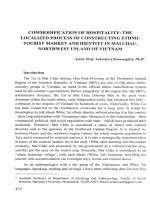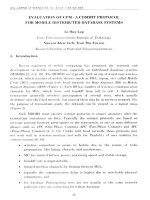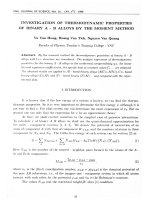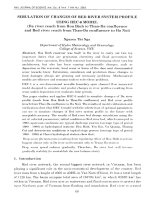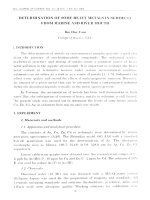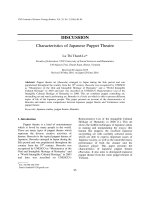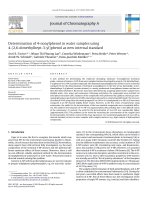DSpace at VNU: Translation of Vietnamese Serial Verb Constructions (SVCs) and or Multi-verb Constructions into English
Bạn đang xem bản rút gọn của tài liệu. Xem và tải ngay bản đầy đủ của tài liệu tại đây (139.34 KB, 10 trang )
VNU Journal of Science: Foreign Studies, Vol. 31, No. 4 (2015) 1-10
Translation of Vietnamese Serial Verb Constructions (SVCs)
and/or Multi-verb Constructions into English
Lâm Quang Đông*
Science and Technology Office, VNU University of Languages and International Studies,
Phạm Văn Đồng, Cầu Giấy, Hanoi, Vietnam
Received 01 October 2015
Revised 28 November 2015; Accepted 30 November 2015
Abstract: Like many languages in West Africa, Southeast Asia, amongst others, serial verb
constructions (SVCs) are popular in Vietnamese in which several verbs appear together as a single
predicate indicating multiple interconnected and/or sequential subevents in a complex event. To
express such a complex event, non-serializing languages like English may require multiple clauses
and/or sentences. Therefore, attempts to render Vietnamese SVCs as a single English predicate in
translation works may not always be successful. This paper aims at addressing such difficulties by
analyzing a number of multi-verb constructions, including SVCs, in Vietnamese from a semanticosyntactic perspective before discussing possible English translation options with illustrative
examples of translation errors collected from the assignments of graduate students at the
University of Languages and International Studies, Vietnam National University, Hanoi (ULISVNU). The paper concludes with a suggested translation process for effectively dealing with
Vietnamese SVCs and multi-verb constructions.
Keywords: SVC, multi-verb constructions, Vietnamese, English, translation.
participants in the sentence semantic structure
are left implicit, including the subject, or a good
number of sentences contain more than one
verb without clear subjects or objects. This is
quite natural in Vietnamese and Kotu, two
among numerous isolating and serializing
languages in the Austro-asiatic family, but I had
to struggle to find proper ways of rendering
them in the English translation. Among the
most difficult are serial verb constructions
(SVCs) and similar multi-verb constructions.
This paper will elaborate such a difficulty from
a semantico-syntactic perspective, discuss
possible ways for translation of Vietnamese
1. Introduction∗
In 2014, in an international project
concerning the Kotu language, I was assigned
to translate the Kotu-Viet Dictionary [1] into
English. I had no knowledge of the Kotu
language, so I had to rely merely on the
Vietnamese explanations as the source language
(SL). During the translation process, I
encountered various difficulties, as many of the
Vietnamese examples did not provide me with
sufficient information or context, e.g. several
_______
∗
Tel.: 84-913323447
Email:
1
2
L.Q. Đông / VNU Journal of Science: Foreign Studies, Vol. 31, No. 4 (2015) 1-10
SVCs and similar multi-verb constructions into
English and offer hopefully useful implications
for Vietnamese-English translation in general.
2. SVCs and similar multi-verb constructions
in Vietnamese – a brief description
Like many languages in West Africa,
Southeast Asia, amongst others [2], serial verb
constructions (SVCs) are popular in Kotu and
Vietnamese in which several verbs appear
together as a single predicate indicating
multiple interconnected and/or sequential
subevents in a complex event. In our previous
study [3], based on various criteria, particularly
the semantic roles assumed by these verbs and
their status, we were able to identify a nonexhaustive list of SVCs with two verbs in
Vietnamese as follows:
‘I merely risk my life fighting with you and
your father!’
E4. (Hà Đức Hậu)
Bé
chăm lo
small
care
Tôi
tập
suy nghĩ
I
practice
think
về
mọi hành động của mình.
about all
act
c. Manner SVCs, e.g.
E5. (Tô Hoài)
Dế
đi khắp thế gian này
định
also intend go
all
world
this
‘Trui and I also intend to travel all over this world.’
chị
Cốc
d. Resultative/Consequential SVCs, e.g.
E6. (Nam Cao)
Sự thực
truth
giết
kill
chết
những
2
die
PL
mơ
ước
lãng mạn
wish dream romantic
‘Truth kills all romantic dreams.’
E7.
Chị
Sister
nghỉ
rest
ấy
that
ốm.
sick
‘She took a sick leave.’
e. Directional SVCs, e.g.
E8. (Nam Cao)
Four CL chair rattan BEN3 go boat come home land of Điền
‘The four rattan chairs were privileged to travel
by boat to Điền’s home village.’
b. Persona SVC, e.g.
E9. (Nam Cao)
E3. (Nam Cao)
Đi
go
Tao chỉ liều chết với
I
mắt nhìn
Bốn cái ghế mây được đi tàu thủy về quê của Điền
E2. (Tô Hoài)
I and Trũi
hé
‘Dế Choắt peeped at Sister Cốc.’
‘I practiced thinking thoroughly of all my acts.’
Tôi và Trũi cũng
Choắt
Cricket tiny slightly open eye look sister Cormorant
I1
of
nhà.
house
‘The small child cares for cleaning the house.’
(1) Asymmetrical SVCs: including the
following common constructions
a. Event SVCs, e.g. E1. (Tô Hoài)
quét
sweep
bố
con
nhà
mày thôi!
vào
enter
nhà
house
uống
drink
nước!
water
‘Let’s go inside for some water!’
only risk die with father child house you only
f. Causative SVCs, e.g.
E10. (Nam Cao)
_______
Lão
1
Please note in passing that the gloss underneath each
Vietnamese example in this paper merely provides one
notable sense/use among different senses/uses of the
Vietnamese lexical items, or the particular function they
are performing in this context, and they may not be the
best equivalent to the Vietnamese counterparts.
làm
old make
lão
old
khổ
chứ
ai
làm
suffer but who make
_______
2
3
PL: plural marker
CL: classifier; BEN: benefactive marker
lão
khổ
old
suffer
3
LQ. Đông / VNU Journal of Science: Foreign Studies, Vol. 31, No. 4 (2015) 1-10
‘It is the old man, not any others, who caused
suffering to himself.’
g. Posture SVCs, e.g.
hôm sau Điền ngồi viết, giữa
tiếng con khóc
Morning day after Điền sit write amidst sound child cry
‘The next morning, Điền sat writing amidst his
children‘s crying.’
E12. (Vũ Quần Phương, Huy Thục)
Em
đứng trên cầu
đợi
I
stand
on bridge wait
anh
you
a. Idiomatic SVCs, e.g. cày sâu cuốc bẫm
(lit. Plough deep, hoe thoroughly, i.e. till the
soil well), cao chạy xa bay (lit. Fly high and run
far, i.e. Flee/ run away as far as possible);
I
go look for you but you
điếu châm đóm hút thêm điếu nữa
‘He then filled the pipe with tobacco again, set
fire to the spill and took another puff.’
f. Beneficial SVCs, e.g.
Bính mời bà cụ lại hàng mình, nhường cái ghế con cho bà cụ ngồi
Bính invite old lady come store I give CL stool child give old lady sit
‘Binh invited the old lady to her store and gave
her the little stool for her to sit.’
Song anh có
E13. (Phan Nhân)
em chứ em
Rồi hắn lại nhịt thuốc vào nõ
E20. (Tô Hoài)
b. Purposive SVCs, e.g.
tìm
E18. (Nam Cao)
E19. (Nguyên Hồng)
(2) Symmetrical SVCs, including
đi
‘He dashed in, sat straight down, poured spirit
out into the bowl and drank.’
Then he again fill tobacco enter champer pipe light spill smoke extra puff more
‘I stood waiting for you on the bridge.’
Tôi
E17. (Nam Cao)
Hắn xồng xộc chạy vào, ngồi sụp xuống, rót rượu ra bát uống
He force fully run enter, sit collapse down, pour liquor out bowl drink
E11. (Nam Cao)
Sáng
e. Sequential/Consecutive SVCs, e.g.
ở
live
nơi
đâu
place where
‘I went searching for you, but where were you?’
E14. (Nam Cao)
Sao không vào tôi chơi?
why
not enter me play
‘Why not come into my house for a chat?’
c. Instrumental SVC, e.g. E15. (Tô Hoài)
Trũi dùng càng khẽ hích tôi một cái
Trũi use pincers slight push I one CL
‘Trui used his pincers to give me a slight push /
Trui pushed me slightly with his pincers.’
d. Perceptive SVCs, e.g.
E16. (Tô Hoài)
Xem tao trêu mụ
Cốc
đây này!
watch I tease woman Cormorant here this
‘Watch me tease the Cormorant now!’
cho em nói em mới dám nói
phép
but you have allow I speak I only dare speak
‘But I can only dare to speak if you allow me
to.’
Apart from SVCs with two verbs,
Vietnamese sentences abound in SVCs with
three, four or more verbs, and Bisang [4] even
provided an example containing no other parts
of speech but a series of verbs, e.g. E21.
Muốn
want
được
thua
phải
đi
hỏi
know win
biết
lose
must
go
ask
‘If you want to know who wins or loses, you
must go to ask (somebody).’
Semantic as well as syntactic relations
among these verbs may not be easily
identifiable to inexperienced translators, which
results in countless errors like those I found
among most graduate students in my course.
4
L.Q. Đông / VNU Journal of Science: Foreign Studies, Vol. 31, No. 4 (2015) 1-10
Following are essential details of my data
collection.
3. Collection of data
In an assignment for the course in General
Linguistics offered at ULIS-VNU, I asked the
graduate students to translate the Kotu-Viet
dictionary from Vietnamese into English, each
being responsible for only 2 pages (around 35
lexical entries with illustrative examples of how
they are used). These graduate students are
mostly Vietnamese teachers of English, i.e. they
are native speakers of Vietnamese and their
English proficiency ranges between CEFR B2
and C1 levels, or 6.0-8.0 IELTS. I anticipated
that they would face several types of difficulties
due to differences between the two languages.
They then had to choose from 1 to 3 types of
difficulties among those they encountered to
write about in the assignment, using their
linguistic knowledge gathered from the course.
They were free to choose their perspective,
either a contrastive analysis, a typological
discussion of an inflectional language (English)
and an isolating one (Vietnamese), a semantic
explanation, a syntactic comparison at word or
sentence level, etc. On the due date, 120
students turned in their papers.
As expected, the students committed a good
number of errors, both at word level and
phrase/sentence level, both semantic and
syntactic. For the purpose of this paper, I will
merely focus on errors concerning SVCs and
similar multi-verb constructions. Examples of
errors from one student’s assignment are shown
below:
E22.
Trượt ngã, văng
kính
đâu mất.
slip
fall
fly spectacles where lose
S (student’s error): Slipping and falling
makes the glasses be thrown somewhere.
E23.
Mệt
quá, ngã
quỵ
xuống.
Tired excessive fall collapse down
S: It’s tired enough to collapse.
E24.
Uống rượu thấy chuếnh choáng
Drink liquor find
groggy
S: Drinking wine made me feel dizzy.
E25.
Đưa
võng cho
sway hammock give
em bé
baby
ngủ
sleep
S: Sway the hammock for the baby’s sleep.
E26.
Lấy
take
ô
che
umbrella cover
mưa
rain
S: Take an umbrella to avoid the rain.
E27.
Dìu
ông
support grandfather
đi
go
từng
each
bước.
step
S: Carry the grandfather step by step.
E28.
Lấy
đũa
con
Take chopstick child
ăn
eat
cơm.
rice
S: Take little chopsticks to have meal.
E29.
Rắn hổ mang cắn
Snake cobra bite
chết
die
người.
human
S: Copperhead bite deadly.
E30.
Cắt
dọc
chop
stem
khoai
yam
cho
give
S: To chop potatoes for pig.
lợn
pig
ăn
eat
LQ. Đông / VNU Journal of Science: Foreign Studies, Vol. 31, No. 4 (2015) 1-10
5
As can be seen, this student fails to
establish semantic relations among components
of these sentences while a number of
participants in the event described by these
sentences are absent. She consequently fails to
identify the main clause from the subordinates,
which eventually leads to syntactical errors in
her hardly comprehensible translation. This
student is not alone in this regard; similar errors
are found in the assignments of other students
as well. Apart from the students’ lack of
experience in translation work, this must also
be due to the nature of the Vietnamese language
itself, particularly SVCs and multi-verb
constructions. The following section will
analyze each of the 9 instances above so as to
provide better understanding of their semantic
and syntactic structures.
can be I – the first person, i.e. the speaker. As
the comma indicates, the SVC functions as an
adverbial clause specifying the reason or cause
of the subevent in the main clause. Meanwhile,
the main clause does not share the same subject
with the SVC; in fact, the spectacles associate
with the verb fly in a kind of middle voice. Such
use of the middle voice is invisible to the
student. She understood the cause-effect
relation between these clauses, as evident in her
use of the causative verb makes, but that is all.
Her translation does not clarify who slipped and
fell, who the glassses belong to, and the fact
that the glasses have not been found is not
indicated by any means, either. The biggest
problem is that she tries to compact all the three
subevents in a single clause with the finite verb
makes, which is utterly impossible.
4. Analysis
The same problem shows up in the next
example:
E23.
Mệt
quá, ngã
quỵ
xuống.
Tired excessive fall collapse down
E22.
kính
đâu mất.
Trượt ngã, văng
slip
fall
fly spectacles where lose
This sentence contains at least three verbs
trượt (slip), ngã (fall) and văng (fly), while the
last mất (lose) is not normally regarded as a
verb in Vietnamese; rather, it is considered a
modal particle indicating some negative or
malefactive impact of the event on the speaker.
Therefore, the first two verbs are classified as a
resultative/consequential SVC: [someone] fell
as a result of slipping. This subevent, in its turn,
results in the spectacles flying off that person
and landing somewhere and they have not been
found. Semantically, the event described by this
sentence is highly complex, with three
successive subevents, one leading to another.
To make the matter worse, syntactically, the
SVC does not have an explicit subject – this
subject must be inferred from the context, and it
The main and subordinate clauses also have
cause-effect relation, but they share the same
implicit subject, which can be either the first or
the third person, singular or plural. It is
interesting to note that the SVC ngã quỵ4
contains two verbs ngã and quỵ, with the latter
modifying the manner of the act denoted by the
former – one possibility is that the
person/people fell quite abruptly with their
knees bent down under their own weight (c.f.
ngã gục/double oneself when fell, ngã
nhào/topple, ngã lăn/tumble, ngã ngửa/fall
back, etc.) Yet, in English, a single verb
_______
4
A number multi-verb constructions which I classify as
SVCs may have traditionally been regarded merely as
compounds. See my detailed discussion of this point in
[3].
6
L.Q. Đông / VNU Journal of Science: Foreign Studies, Vol. 31, No. 4 (2015) 1-10
collapse may suffice because it entails the act of
falling and more or less indicates the manner of
falling. Verbs like collapse, stagger, stumble,
etc. can therefore be referred to as Manner
verbs, which means they denote not only the
action but also the manner of the action, i.e.
manner is given in the verbs themselves in a
process
called
argument
fusion
[4].
Nevertheless, the student renders the
Vietnamese sentence in an ill-formed English
one: It’s tired enough to collapse.
She seems to make a little progress with the
third case,
E24.
Uống rượu thấy chuếnh choáng
Drink liquor find
groggy
when the causative structure with makes is used
grammatically with the insertion of the
experiencer me: Drinking wine made me feel
dizzy. The purposive SVCs in E25
Đưa
võng cho em bé
ngủ
sway hammock give baby sleep
and E30
Cắt
dọc
chop
stem
khoai
yam
cho
give
lợn
pig
ăn
Eat
are translated as Sway the hammock for the
baby’s sleep and To chop potatoes for pig,
which may sound acceptable when the Purpose
cum Beneficiary marker cho is properly
replaced with its English equivalent for. When
it comes to instrumental SVCs, however,
problems recur:
E26.
Lấy
ô
che
Take umbrella cover
mưa
rain
S: Take an umbrella to avoid the rain.
E28.
Lấy
đũa
con
Take chopstick child
ăn
eat
cơm.
rice
S: Take little chopsticks to have meal.
My previous study [3] reveals that
instrumental SVCs in Vietnamese like these
present a dilemma: it is not possible to
determine which of the verbs in the SVC is the
governing one over the other. If it is the first,
then the second functions as the purpose; if it is
the second, then the first merely describes the
act of acquiring the instrument so as to perform
the action denoted by the second. These two
instances provide evidence of the fuzzy lines
between the various types of SVCs, i.e. many
SVCs can be rightfully classified as purposive,
benefactive/beneficial
or
instrumental,
depending on what is taken as the governing
verb. Consequently, the names given to these
types are relative in nature for the mere purpose
of emphasizing some distinction among them
and facilitating our SVC analysis. Returning to
the two cases in question, the student succeeds
in providing the purpose of the action denoted
by the first verb with the to-infinitive in
English, which ensures the grammaticality or
well-formedness of the translation, but the
meaning seems to have been somewhat altered
due to her wrong choice of verb (to avoid), and
the cultural feature of the Vietnamese people
with regards to the use of chopsticks in cooking
and eating is not fully conveyed.
Now that the semantic and syntactic
structures of the 9 instances have been clarified,
the next question is how to properly translate
them into English – which would be the better
option, semantic or communicative/pragmatic
translation – so as to avoid this kind of errors.
LQ. Đông / VNU Journal of Science: Foreign Studies, Vol. 31, No. 4 (2015) 1-10
5. Semantic vs. communicative/pragmatic
translation
As analyzed above, SVCs and multi-verb
constructions in Vietnamese are highly
complex, involving different layers and aspects
of meanings, and are sophisticated in their
syntactic structures so that they can describe
multiple subevents in an inclusive, over-arching
one culturally conceptualized as a single event
or a single interconnected, sequential series of
events. One among common criteria for a series
of verbs to be classified as a prototypical SVC
across languages is that the verbs must share at
least one argument, typically the subject [2:3]
[5], but Vietnamese SVCs go further: a number
of verbs may appear side by side even when
there seems to be no shared argument [6], e.g.
E31.
Máu
blood
chảy
flow
thành sông.
become river
‘Blood flows like a river.’
SVCs “show semantic and functional
similarities to multiclausal and subordinating
constructions in non-serializing languages”
[2:2-3]. They ‘serve to provide in a uniform
way the sort of information that in the surface
grammar of languages like English is handled
by a formally disparate array of subordinating
devices: complementary infinitives, -ing
complements, modal auxialiaries, adverbs,
prepositional phrases, even whole subordinate
clauses’ [Matisoff (1969:71), in [2:3]. Although
Aikhenvald and Dixon [2:4] believe that ‘SVCs
are often translatable as single predicates into
non-serializing languages’, they note that some
problems may arise when translators attempt to
use a single predicate in a non-serializing
language for an SVC in a serializing one.
This is exactly the case in question. These
students try to replace the Vietnamese SVCs
7
and/or multi-verb constructions with a single
predicate in English while the verbs may not
share the same argument and the semantic roles
and/or relations among various components of
the sentences are not clear to them; hence their
errors. They should have started first with
semantic, then syntactic understanding of these
SVCs and multi-verb constructions. Next, they
have to consider how to render them in English.
Would a semantic or communicative/pragmatic
translation be an apppropriate rendition of
Vietnamese
SVCs
and
multi-verb
constructions? There could be different
answers, because a number of factors need to be
considered.
First, for the type of explanative
dictionaries like the Kotu-Viet-English
dictionary we were working on, a semantic
translation is necessary. All the subtleties of the
literal and figurative meanings of the source
language (SL) lexical items and their uses need
to be clearly described in order for the
dictionary users to thoroughly understand them
and properly use them. Naturally, this would
probably result in an SL SVC or multi-verb
construction being explained in lengthy,
multiclausal sentences in the target language
(TL), which means the TL may not correspond
to the SL syntactically. Also, the translator has
to insert such necessary elements as the subject
for the English to be well-formed, which adds
extra-modification to the grammatical structure
of the TL compared to the original. For
instance, example E22 is likely to be translated
as, amongst others,
As I slipped and fell, my glasses flew off and
I can’t find them yet.
or When I fell due to a slippage, my
glasses flew off and I haven’t found them yet.
8
L.Q. Đông / VNU Journal of Science: Foreign Studies, Vol. 31, No. 4 (2015) 1-10
The focal lexical item being explained here
is fly (off), and since Vietnamese words never
change their form to show tenses, the translator
has to base himself/herself on the context to put
the English verbs into their proper form to
express this grammatical category. As can be
seen, for the meanings of the original sentence
to be fully and clearly translated, two or three
clauses are required in the English version.
In the same manner, the remaining eight
sentences can be rendered, for instance, as:
E23. Too tired/exhausted, I/he/she/we/they
collapsed.
E24. I found myself groggy after drinking.
E25. She swayed the hammock for the baby
to sleep.
E26. He opened the umbrella to ward off
the rain / He protected himself from the rain
with the umbrella.
E27. I supported my grandfather to walk
step by step.
E28. Get the little chopsticks for the meal /
Have rice with little chopsticks.
E29. Cobras can bite people dead (if this is
a generic description) / A cobra bit someone
dead (if this describes a particular event that has
taken place).
E30. I chopped the yam stems to feed pigs.
What personal pronouns can be inserted in
these English sentences depends on the
inference from the particular context, which
unfortunately is not sufficiently given by the
authors of this dictionary. Furthermore, for the
example E28, a little cultural note should be
added, e.g. the Vietnamese people traditionally
use large chopsticks for cooking and serving
rice from the pot to the bowl(s), while each
individual uses smaller chopsticks for picking
up the food from the large tray and serving
himself/herself from his/her own bowl. These
analyses demonstrate that syntactic simplicity
has to sacrifice for the TL to fully cover the
semantic complexity of the SL if this kind of
dictionary wants to provide detailed explanation
of SVCs and similar multi-verb constructions of
Kotu and Vietnamese in a non-serializing
language like English.
By contrast, such cumbersome grammatical
structures should not be allowed if economical
principle is being pursued for communicative
purposes and the most important goal is to get
the message across. In other words, in daily
conversations, for instance, communicative or
pragmatic translation must be the option.
Certain senses of the lexical items in the SVCs,
some “shades of meanings”, or sophisticated
attributes expressed by Vietnamese SVCs or
multi-verb constructions, might be lost in the
process, particularly when translators try to
compact them in a single English predicate, as
one of our previous papers has argued [7].
6. Conclusion
The analysis and discussion above lead us
to the following suggestion: when translators
encounter SVCs or multi-verb constructions in
serializing languages like Vietnamese and have
to translate them into a non-serializing one like
English, it is advisable that they:
i) perform a stepwise semantic analysis, for
instance, the sentence
E32. Mình đem thằng Dế này quẳng ra ao
cho “xừ” vịt bầu sực một bữa (Tô Hoài)
can be analyzed as follows:
9
LQ. Đông / VNU Journal of Science: Foreign Studies, Vol. 31, No. 4 (2015) 1-10
E32
Mình
đem
thằng Dế này
quẳng
ra
ao
cho
“xừ”vịt bầu
sực
một bữa
Layer 1Semantic
Roles
Layer 2 –
Semantic
Roles
Layer 3Semantic
Roles
Agent
V1
Theme
V2
Direction
Goal1
V3
Goal2
V4
Theme
Recipient
Beneficiary
Patient
Agent
because thằng Dế này is Theme to both V1
đem and V2 quẳng, and Patient to V4 sực; ao is
Goal to V1 đem and V2 quẳng; “xừ” vịt bầu is
both
Goal
to
V2
quẳng,
and
Recipient/Beneficiary to V3 (which is a coverb
rather than a verb proper in this function) cho
and Agent to V4 sực. Literally, the sentence can
be glossed as:
Mình
đem
thằng
Dế
này
quẳng
ra
ao
cho
“xừ”
We
bring
CL
(vulgar)
Cricket
this
throw
out
pond
for
monsieur
(French)
Naturally, translators are not necessarily
required to name the participants in the
sentence’s semantic structure as exactly as
these, but at least they should be able to identify
the semantic relations among them. This would
facilitate their choice of the syntactic elements
and structure of the TL in the next steps;
ii) establish syntactic functions of the
various components of the SL sentence;
iii) consider the purpose of the translation
and other important factors so as to choose
among the various translation options available;
iv) determine the possible syntactic
structure for the TL, separating the SL SVCs or
multi-verb constructions into several clauses if
necessary; and finally,
v) produce the TL version, e.g.
(E32a) We would throw this Cricket to the
pond so that “Madame” duck could have a
good meal.
(E32b) We would throw this Cricket to the
pond as a good meal for the duck.
vịt
bầu
duck
sực
một
bữa
eat
(slang)
one
meal
(E32c) Let’s turn this Cricket into a good
treat for the duck, etc.
Hopefully, this suggested procedure would
help translators better understand Vietnamese
SVCs and multi-verb constructions and render
them properly in English so as to avoid the
kinds of errors found in our graduate students’
assignments.
References
[1] Nguyễn Văn Lợi et al (2007). Từ điển Cơ TuViệt; Việt-Cơ Tu (Kotu-Viet, Viet-Kotu
Dictionary). Hanoi: Social Sciences Publisher.
[2] Aikhenvald, Alexandra Y. and Dixon, R.M.W
(eds.) (2006) Serial Verb Constructions, A CrossLinguistic Typology. New York: Oxford
University Press.
[3] Lâm Quang Đông (2013). Cấu trúc nghĩa biểu
hiện của câu có kết cấu vị từ chuỗi tiếng Việt và
kết cấu tương ứng trong tiếng Anh
(Representational semantic structure of sentences
with serial verb constructions and their
equivalents in English). VNU research project
QG.12.44.
10
L.Q. Đông / VNU Journal of Science: Foreign Studies, Vol. 31, No. 4 (2015) 1-10
[4] Pinker, Stephen (1993). Learnability and
Cognition – The Acquisition of Argument
Structure. Cambridge: the MIT Press.
[5] Bisang, Walter (1995). Verb Serialization and
Converbs – Differences and Similarities. In
Haspelmath, Martin and König, Ekkehard (ed.)
Converbs in Cross-Linguistic Perspective. Berlin:
Mouton de Gruyter, pp. 137 – 188.
[6] Lâm Quang Đông (2014). Một số đặc thù của kết
cấu vị từ chuỗi tiếng Việt (Peculiarities of
Vietnamese serial verb constructions). In
Proceedings of the International Conference The
Linguistics of Vietnam in the Context of
Renovation and Integration. Hanoi: Institute of
Linguistics, VASS, pp. 714-738.
[7] Lâm Quang Đông (2013). Sự chênh nghĩa giữa vị
từ đơn tiếng Anh và vị từ chuỗi tiếng Việt, và thất
thoát nghĩa khi dịch (Meaning gaps between
English single verb and Vietnamese serial verbs,
and meaning loss in translation). Lexicography
and Encyclopedia, No.1, pp. 3-9.
Sources of data for illustration
Nam Cao (2009). Tuyển tập truyện ngắn
(Anthology of Short Stories). Hanoi: Kim Đồng
Publisher.
Hà Đức Hậu’s song Bé quét nhà (Little Child
Cleaning the House).
Tô Hoài (1941). Dế mèn phiêu lưu ký (Diary of a
Cricket). Hanoi: Thời đại Publisher (reprint 2011).
Nguyên Hồng (1938). Bỉ vỏ (A Woman
Pickpocket). Hanoi: Literature Publisher (reprint
1982).
Phan Nhân’s song Em ở nơi đâu? (Where are you?)
Vũ Quần Phương and Huy Thục’s song Đợi (Wait).
Chuyển dịch kết cấu vị từ chuỗi và/hoặc kết cấu đa động
tiếng Việt sang tiếng Anh
Lâm Quang Đông
Phòng KH-CN, Trường Đại học Ngoại ngữ, ĐHQGHN, Phạm Văn Đồng, Cầu Giấy, Hà Nội, Việt Nam
Tóm tắt: Như nhiều ngôn ngữ ở Tây Phi, Đông Nam Á cũng như các vùng khác, kết cấu vị từ chuỗi (SVC)
rất phổ biến trong tiếng Việt, trong đó nhiều động từ cùng xuất hiện bên cạnh nhau như một vị thể đơn nhất, biểu
thị nhiều tiểu sự tình gắn bó mật thiết với nhau và/hoặc có tính tuần tự, kế tiếp nhau trong một sự tình phức hợp.
Để thể hiện một sự tình phức hợp như thế, các ngôn ngữ phi chuỗi như tiếng Anh có thể cần tới nhiều mệnh đề
và/hoặc nhiều câu khác nhau. Do vậy, trong quá trình dịch thuật, nếu người dịch cố gắng diễn đạt SVC tiếng
Việt bằng một vị thể đơn nhất trong tiếng Anh thì không phải lúc nào cũng thành công. Bài viết này bàn về
những khó khăn đó qua việc phân tích một số kết cấu đa động, bao gồm SVC, trong tiếng Việt theo quan điểm
ngữ nghĩa-cú pháp, sau đó sẽ thảo luận một số phương án chuyển dịch khả dĩ sang tiếng Anh với những ví dụ về
lỗi dịch thuật thu thập được qua tiểu luận của học viên cao học tại Trường Đại học Ngoại ngữ - Đại học Quốc gia
Hà Nội. Cuối cùng, bài viết đề xuất một quy trình dịch thuật có thể áp dụng để xử lý hiệu quả SVC và kết cấu đa
động tiếng Việt khi dịch sang tiếng Anh.
Từ khóa: Kết cấu vị từ chuỗi, kết cấu đa động, tiếng Việt, tiếng Anh, dịch thuật.

